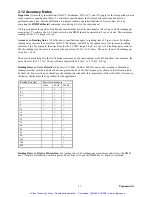
27
Signametrics
ractical, higher current measurements be limited to short time. The lower two ranges of DC current may be
seem unstable or high, while in IDC measurement, apply
ent Measurements
or low level current measurements use the
V,
Ω
+
and
V,
Ω
-
terminals. Using the 33V DCV range, the
SMX
urement function is facilitated by the DMM’s low
value that can be
easured has more to do with the user’s acceptable burden voltage (the voltage drop across the
1
0.0M
Ω
s
esistance is measured with one of eight (six in the SMX2040) precision current sources, with the DMM displaying
ce measurement modes are susceptible to Thermo-Voltaic (Thermal EMF)
errors. See section section 4.3.5 for details.
Ohms method. Simply connect
V,
Ω
+
to one
nd of the resistor, and the
V,
Ω
-
to the other end. If the resistor to be measured is less than 30 k
Ω
, you should null
You may also want to control the Ohms current used in making resistance measurements. (See the Specifications
section, "Resistance, 2-wire and 4-wire", for a table of resistance range vs. current level.) All of the Ohms ranges of
the SMX2040 have enough current and voltage compliance to turn on diode junctions. For characterizing
semiconductor part types, use the Diode measurement function. To avoid turning on a semiconductor junction, you
may need to select a higher range (lower current). When checking semiconductor junctions, the DMM displays a
resistance value linearly related to the voltage across the junction.
For applications requiring resistance measurements higher than 330 M
Ω
, the Extended Resistance Measurement
method is available with the SMX2044.
4.3.2 4-wire Ohm Measurements
4-wire Ohms measurements are advantageous for making measurements below 330 k
Ω
, eliminating lead resistance
errors. The
Voltage
(
V,
Ω
) Input terminals serve as the current “Source” (i.e. they provide the current stimulus in the
ohms measurement), and the
I, 4W
Ω
Input terminals are the “Sense” inputs. The and Sense + leads are
connected to one side of the resistor, and the Source - and Sense - leads are connected to the other side. Both Sense
leads should be closest to the body of the resistor. See Figure 4-3.
4-wire Ohm makes very repeatable low ohms measurements, from 100
µΩ
(10
µΩ
for SMX2042, 44) to 330 k
Ω
. It
is not not recommended to us
4W
Ω
when making measurements above 100 k
Ω
, although 4-wire ohms is allowed
p
effected by relay contamination. If the measurements
between 20mA and 50mA DC to the current terminals and clean the K2 relay using the
DMMCleanRelay(0, 2,
200)
. Repeat this until the measurements are stable.
4.2.2 Low Level DC Curr
F
2040 can measure very low currents. This hidden meas
leakage front-end and a virtual 1
0.0M
Ω
input resistance. With a typical offset error of less than 100
µ
V in
this VDC range, it is practical to measure down to 20pA. The maximum current
m
shunt) then the DMM limitations. Assuming a maximum burden voltage of 3.3V the maximum current
level is 330
η
A. This range is well within leakage measurements required in most semiconductor testing.
It is also a very quite and stable. Since the DMM does not have an explicit low current function, it i
necessary to calculate the current, which is equal to the measured voltage divided by
1
0.0M
Ω
.
4.2.3 Extended DC Current Measurements (SM2044)
The leakage measurement function can also be used to measure low-level currents. Using a relatively high value
shunt resistor and setting the leakage test voltage to 0V allows measurements of super low level currents, without
any burden voltage. Read the leakage current section of the manual for more details.
4.3 Resistance Measurements
R
the resistance value. Most measurements can be made in the 2-wire mode. 4-wire ohms is used to make precision
low resistance measurements. All resistan
4.3.1 2-wire Ohm Measurements
The DMM measure using 330
Ω
to 33 M
Ω
ranges. The SMX2042 and SMX2044 add 33
Ω
and 330 M
Ω
ranges.
Use the
V,
Ω
+, V,
Ω
-
terminals, being certain to always disconnect the
I+, I-
terminals.
Most resistance measurements can be made using the simple 2-wire
e
out any lead resistance errors by first touching the
V,
Ω
+
and
V,
Ω
-
test leads together and then performing a
Relative
function. If making measurements above 300 k
Ω
, you should use shielded or twisted leads to minimize
noise pickup. This is especially true for measurements above 1 M
Ω
.
Artisan Technology Group - Quality Instrumentation ... Guaranteed | (888) 88-SOURCE | www.artisantg.com






























